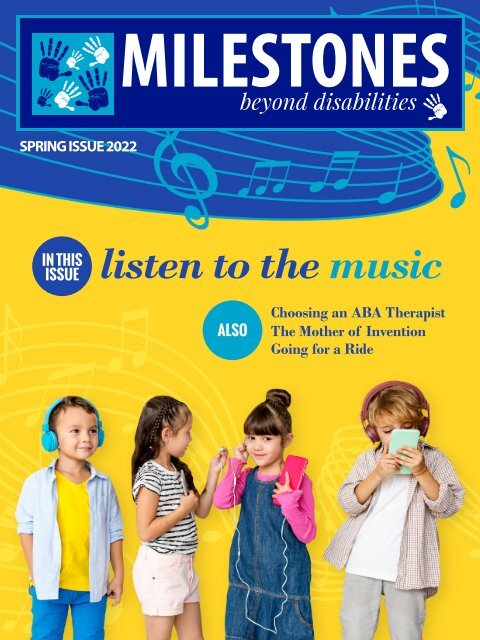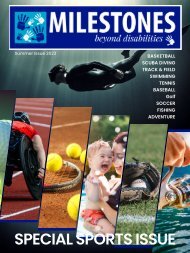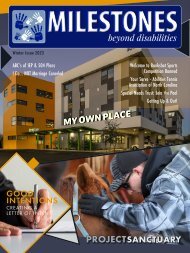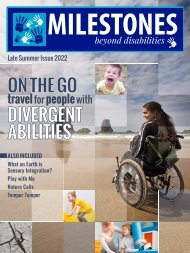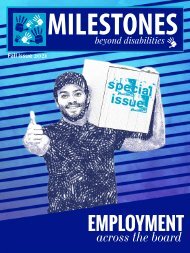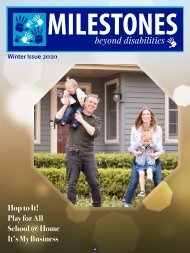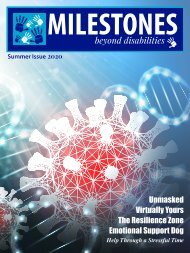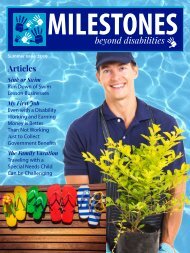Milestones Spring Issue 2022
Helping Individuals with Disabilities & their Families Achieve & Celebrate Events & Milestones in their Lives
Helping Individuals with Disabilities & their Families Achieve & Celebrate Events & Milestones in their Lives
You also want an ePaper? Increase the reach of your titles
YUMPU automatically turns print PDFs into web optimized ePapers that Google loves.
eyond disabilities<br />
SPRING ISSUE <strong>2022</strong><br />
IN THIS<br />
ISSUE<br />
listen to the music<br />
Choosing an ABA Therapist<br />
ALSO<br />
The Mother of Invention<br />
Going for a Ride
Publisher<br />
Susie Redfern, is the parent of a<br />
special needs child who recently<br />
“aged out” of the public-school<br />
system.<br />
05<br />
She developed <strong>Milestones</strong><br />
Magazine to help individuals with<br />
disabilities and their families<br />
achieve and celebrate events and<br />
milestones in their lives.<br />
ON THE COVER<br />
Listen to the Music<br />
info@milestonesmagazine.com<br />
<strong>Milestones</strong>Magazine.net<br />
FEATURES<br />
03<br />
Born Too Soon<br />
09<br />
Choosing an ABA Therapist<br />
13<br />
8<br />
The Mother of Invention<br />
15<br />
Acting Up or Acting Out: What’s the solution?<br />
19<br />
Going for a Ride<br />
21<br />
IEP Advocate, anyone?<br />
23<br />
There’s an Association for That<br />
1
Born Too Soon<br />
Most everybody who is expecting<br />
a baby hopes for a child that is<br />
born healthy and full-term.<br />
Things don’t always go according to plan, however, and perhaps the most common<br />
complication is that of a child born prematurely. The most well-known, life-threatening<br />
complications, are the difficulties such children have with regulating their body<br />
temperature to stay warm enough, and undeveloped lungs where they often cannot<br />
breathe on their own.<br />
Beyond these life-threatening complications (and others not listed), however, are a host<br />
of other issues that can lead to short-term developmental delays in some cases, and lifelong<br />
difficulties in others. One such circumstance, which I was introduced to, is a brain<br />
bleed. This complication can put children at risk for conditions such as Cerebral Palsy. To<br />
explain more about this, I am pleased to introduce Physical Therapist Teresa Alliston.<br />
3
Most infants born prematurely (those infants born before 37<br />
weeks of pregnancy are completed) also have a low birth weight.<br />
Infants are placed in the low-birth weight category at 5 pounds 5<br />
ounces (2500 grams). Premature, low birth weight infants, can be are at risk<br />
of brain bleeds, or otherwise referred to by medical staff as Intraventricular<br />
hemorrhage IVH. Infants born at term may also experience an IVH, but<br />
have a much lower risk of this happening. Intraventricular hemorrhages, for<br />
the most part occur sometime within the first few weeks after birth.<br />
An Intraventricular hemorrhage for an infant is similar to<br />
a stroke for an adult. Just like a stroke there are varying<br />
degrees of the amount of the bleed within the brain’s<br />
area. These levels of degree for the infant are referred<br />
the NICU/hospital. But, in that moment of dealing with,<br />
and surviving that time in the hospital with your young<br />
infant, it is hard to take in and process all the information<br />
that is given to you.<br />
to as “Grades”, and range from a low grade, rated as a<br />
Grade I, IVH; to the most severe known as a Grade IV,<br />
IVH. Similar to a stroke as well, is the effect the blood<br />
in the area of the brain tissue may have on the patient’s<br />
various areas of abilities to move, see, speak, the process<br />
thinking/problem solving. The lesser the Grade of bleed<br />
the lesser the level of impact on the patient’s various<br />
abilities, the greater the Grade of bleed the greater the<br />
As a Physical Therapist that has a passion for preterm/<br />
low birth weight infants, I would be happy to have a<br />
conversation with you about any questions you may have.<br />
You are welcome to contact me at Pediatric Therapy of<br />
Washington State, PLLC through the “book a consult”<br />
tab on the home page of www.ptows.com. Just put your<br />
question in the comment/message box, and I will know<br />
level of impairment on the patient’s various ability to<br />
move, see, speak, or think/problem solve. Based on the<br />
area(s) of the brain tissue which the blood has affected,<br />
determines the area(s) of the infant’s abilities that may be<br />
impaired. For example, if the motor area of the brain has<br />
blood affecting that area, then the possible result will be<br />
an impact to the physical movements of the infant.<br />
you have a question, and are not looking for a consult.<br />
M<br />
Grades I and II, IVH’s, may temporarily show some mild<br />
impacts on the infant’s abilities for movement, sight, etc.;<br />
but usually resolve on their own without the need for<br />
interventions. For those that do not resolve on their own,<br />
there are treatments available to address the various needs<br />
of the infant. The latest research is showing the sooner the<br />
treatment is started the better the outcomes for the infant.<br />
For Grades III and IV, IVH’s, there is a greater possibility<br />
that the more severe impacts on the infant’s abilities for<br />
movement, sight, etc.: may not resolve on their own,<br />
making these infants more likely candidates for early<br />
treatment options.<br />
Most likely all of this information has been shared with the<br />
family/caregiver of the preterm infant while they were in<br />
Editor’s Note: Teresa is a future magazine<br />
contributor for articles related to various<br />
assessments and treatments for pre-term and<br />
full-term babies, and young children.<br />
4
COVER<br />
FEATURE<br />
listen to the music<br />
The old saying is<br />
“Music hath charms to soothe<br />
the savage beast.”<br />
There are, probably, just a handful of people throughout<br />
history who qualify as savage beasts (and music probably<br />
wouldn’t soothe them), but music can be inspiring,<br />
enjoyable, and therapeutic for the rest of us.<br />
5
Music therapy, as a service, is available to a variety<br />
of people, including those with disabilities. I am<br />
honored to introduce Fatima, a Senior Music<br />
Therapist/Researcher with Integrative Music<br />
Therapy, LLC to tell us about what they do, and<br />
how neurologic music therapy helps individuals with<br />
disabilities enhance their quality of life.<br />
Introduction<br />
The sound of music ebbs and flows throughout each day<br />
inside the red brick building, where Integrative Music<br />
Therapy, LLC (IMT) operates our clinic. Clients of<br />
all ages with various disabilities enter this “CAN-Do”<br />
environment to receive therapy with goals to enhance<br />
their quality of life. Many people may notice the singing<br />
and playing musical instruments common to our<br />
environment, but many may not know the power that<br />
music has to support change and learning. Did you know<br />
that rhythmic cueing can improve speech articulation<br />
for someone who has experienced a stroke-related<br />
communication challenge? Did you know that the steady<br />
beat of a drum or simple metronome clicks have the power<br />
to improve coordination and efficient movement for<br />
someone with a movement disorder? These are just part of<br />
our innovative and unique approach to therapy, utilizing<br />
our Neurologic Music Therapy (NMT) model.<br />
Rhythm is Key<br />
Internal rhythm exists within each human body like a<br />
personal identity. This unique rhythm flows through<br />
our body to promote regulation and support volitional<br />
movements, which allow most of us to be functional<br />
and purposeful in our lives. Recent neuroscience<br />
evidence suggests that there is a growing number of<br />
neurodivergent individuals whose brains are differently<br />
connected. This leads to exciting gifts and abilities,<br />
but for some, difficulties with emotional and sensory<br />
regulation, and motor planning. This<br />
is recently being described as<br />
“apraxia” or “dyspraxia” and<br />
it may impact speech/<br />
communication,<br />
social interactions,<br />
body awareness,<br />
self-confidence,<br />
community<br />
Why do we provide Neurologic<br />
Music Therapy?<br />
Neurologic Music Therapy (NMT) is an evidence-based<br />
music therapy approach that uses music and rhythm to<br />
improve the way the brain functions during functional,<br />
everyday tasks. This approach utilizes a Transformational<br />
Design Model (TDM) to assess the functional needs of<br />
a client and then design music-based interventions or<br />
exercises to strengthen the neural pathways of the brain<br />
to support a positive change in the individual’s abilities to<br />
carry out the targeted goals. The skills that are developed<br />
during music therapy can then be easily transferred to<br />
other settings outside the music therapy session. Our<br />
therapists believe that a research-based approach is the<br />
most responsible and effective way to support individuals<br />
to obtain therapeutic outcomes.<br />
access, etc.<br />
These unique<br />
brains may<br />
become<br />
overstimulated<br />
by stimuli in<br />
their environment.<br />
Their environment<br />
may consist of a wide<br />
variety of sights, sounds,<br />
smells, tastes, and textures<br />
all at the same time, and that can<br />
greatly impact their ability to regulate their bodies and<br />
move in the way they intended to. Unfortunately, these<br />
support needs are often mis-evaluated or assumed to be<br />
intentional behaviors, leading to therapeutic strategies<br />
meant to “control” the person or “teach compliance”.<br />
6
Fortunately, neurologic music therapy has a very different<br />
focus - one focused on strengths and abilities, along with<br />
a commitment to provide supports and accommodations<br />
the individual needs to best access their life. Sometimes<br />
the support that is needed is simply a rhythm that matches<br />
with the individual’s internal rhythm to help them entrain<br />
and develop new sensory and motor brain connections,<br />
therefore improving body awareness and motor planning.<br />
only provide visual cues and/or written instructions for<br />
the individual to read and respond to. This technique<br />
is an under-utilized support to bodies when needing<br />
to calm, slow down, or regulate, and can really support<br />
co-regulation between a therapist and an individual<br />
receiving music therapy (or a parent/child or a teacher/<br />
student). This approach is especially effective when the<br />
individual’s responses are dominated by the autonomic<br />
nervous system, often referred to as our “fight-flightfreeze”<br />
mode, which commonly occurs when an individual<br />
Never forget about Silence…<br />
That’s part of the music too!<br />
Our fast-paced world often forces us to move and respond<br />
without a break. However, silence is equally important,<br />
just like there are rests within the music. Silence provides<br />
room for our brain to focus, think and process. This leads<br />
us to the common mantra at our clinic: “Think, Look,<br />
Move”, which is also associated with a traffic visual that we<br />
have available in every office. We teach our clients to first<br />
STOP and THINK about what they want to do; second,<br />
YIELD and LOOK by utilizing their central vision to<br />
locate their target; and third, GO to MOVE to complete<br />
the desired task. By using this strategy, we have seen many<br />
successful moments when our clients have been able to<br />
becomes overwhelmed or perceives stress or fear.<br />
In order to truly understand the needs of a person<br />
identified to have a disability and to provide an effective<br />
music therapy treatment, it’s important to address the<br />
needs at the brain level. By utilizing a neuroscienceinformed<br />
approach to music therapy (NMT) to guide our<br />
treatment strategies and supports, we can deepen the<br />
way the brain connects and positively enhance outcomes<br />
in sensory processing, meaningful communication, and<br />
purposeful motor skills for individuals who are working<br />
to overcome the limitations of their disability. When<br />
these needs are met, our clients are able to enjoy a truly<br />
meaningful life and improved autonomy. Isn’t that what<br />
we all hope for?<br />
M<br />
participate in activities that they never had found success<br />
to do before.<br />
Contact Information:<br />
Through our neurologic approach, we have found that<br />
“Silent Support” can be crucial to help neurodiverse<br />
individuals regulate their emotions and increase their<br />
body awareness. Silent support requires the support<br />
person to inhibit their own speaking voice to instead<br />
Integrative Music Therapy, LLC<br />
1003 SR 662 W<br />
Newburgh, IN 47630<br />
(812)490-9400<br />
www.inmusictherapy.com<br />
7
YOUR LOVE FOR THEM<br />
IS ENDLESS. LET’S HELP IT<br />
GO EVEN FURTHER.<br />
At Prudential, we understand the challenges of caring for a loved one with special needs.<br />
From daily routines and expenses to preparing for a lifetime of care, we’ll work together to help<br />
meet those challenges for you – and your family.<br />
Contact me today for a no-obligation meeting and complimentary copy of A Caregiver’s Toolkit. With<br />
this toolkit, we’ll discuss key planning considerations and resources to help you build a strong<br />
financial foundation and future full of possibilities.<br />
A CAREGIVER’S<br />
TOOLKIT<br />
Don’t miss out on this valuable experience! Topics include:<br />
• getting organized and staying connected<br />
• avoiding caregiver fatigue<br />
• understanding your legal and estate planning needs<br />
• developing an accessible care plan<br />
• and more!<br />
Planning for the future of your loved<br />
one with special needs so you can both<br />
Live in the moment<br />
The Prudential Insurance Company of America.<br />
1029855-00003-00<br />
1<br />
Nancy Roach-Wilder, CFP ® , ChSNC<br />
Financial Planner, Prudential Advisors<br />
CA Insurance License 0G27220<br />
The Prudential Insurance Company of America<br />
1901 Butterfield Drive, Suite 250<br />
Downers Grove, IL 60515<br />
Office: 630-442-6806<br />
Cell: 224-305-2257<br />
Nancy.roach@prudential.com<br />
www.prudential.com/advisor/nancy-roach<br />
INVEST<br />
• INSURE<br />
• RETIRE<br />
• PLAN<br />
Offering financial planning and investment advisory services through Pruco Securities, LLC (Pruco), under the marketing name Prudential<br />
Financial Planning Services (PFPS), pursuant to separate client agreement. Offering insurance and securities products and services as a registered<br />
representative of Pruco, and an agent of issuing insurance companies. 1-800-778-2255.<br />
Prudential Advisors is a brand name of The Prudential Insurance Company of America and its subsidiaries. Life insurance is issued by The<br />
Prudential Insurance Company of America, Newark, NJ and its affiliates. [Securities products and services are offered through Pruco Securities, LLC<br />
(Pruco)(Member SIPC).] Prudential, the Prudential logo and the Rock symbol are service marks of Prudential Financial, Inc., and its related entities,<br />
registered in many jurisdictions worldwide.<br />
1038386-00001-00 EXP: 05/14/<strong>2022</strong>
Choosing an<br />
ABA Therapist<br />
Children with challenges<br />
of various kinds often have the need for therapists, tutors, and other<br />
professionals to address the issues they are experiencing. For parents,<br />
the challenge is to select the professional that best fits with their child’s<br />
personality and mindset (along with, of course, meeting training and<br />
licensure requirements). The saying making the rounds summarizes<br />
this nicely: “When you know one person with autism, that means you<br />
know one person with autism.”<br />
One size does not fit all.<br />
9
<strong>Milestones</strong> Magazine is honored to introduce IABA Consultants,<br />
which has posted the following article about ABA<br />
Therapy Red Flags, on their blog. ABA Therapy is,<br />
perhaps, the most well-known therapy used for/<br />
with individuals on the Autism Spectrum.<br />
ABA Therapy Red Flags (Part 1)<br />
ABA therapy is the only evidence-based ASD<br />
therapy, but the treatment only works if it is<br />
done with care. Not all ABA service providers<br />
are the same. How can you tell if your child’s<br />
treatment is being conducted correctly?<br />
No Observation or Information<br />
One of the most important aspects of ABA<br />
therapy is continuing a program at home.<br />
If an ABA service provider refuses to share<br />
information or allow observation you may<br />
want to take a closer look at the program.<br />
There are some red flags you can look for<br />
if you feel your child is not progressing or<br />
benefitting from ABA therapy. The points we<br />
are going to talk about won’t cover everything,<br />
but they will cover some of the most easily<br />
observable ABA therapy red flags.<br />
Information should always be available on<br />
how your child is progressing. Daily records<br />
should be available to parents if they want<br />
to know what is going on in treatment. If<br />
an ABA service provider is unable to share<br />
information, it may be time to take a closer<br />
look. Quick note: information and records may<br />
take a few days to be logged, each clinic is<br />
We have split this article into two parts, as we<br />
different.<br />
want to mention why these red flags can be<br />
harmful and what you can do to notice them.<br />
Too Many Hours of Therapy<br />
If you are not allowed to visit your child’s ABA<br />
clinic to observe treatment and progress you<br />
may have a problem on your hands. Dropping<br />
ABA therapy is a billable medical expense. Like<br />
most medically billable services, some ABA<br />
therapy providers will look to bill for as many<br />
hours as possible. Most people don’t require<br />
40+ hours a week of ABA treatment.<br />
Be sure to look at your child’s program and<br />
what exactly is being done from a therapy<br />
standpoint. Does the program cover<br />
everything your child needs? Are the<br />
hours reasonable for the needs of your<br />
child?<br />
A note that some people do need a<br />
lot of therapy, just not everyone. ABA<br />
therapy is not supposed to last forever.<br />
Your child will eventually be able to live<br />
an independent life with honed social<br />
skills. Too many hours of therapy is not<br />
something that will necessarily help with<br />
ABA therapy.<br />
10
y without notice is not recommended, the<br />
situations we are talking about are never<br />
being able to observe your child’s clinic &<br />
program.<br />
ABA Therapy Red Flags (Part 2)<br />
ABA therapy is the only evidence-based ASD<br />
therapy, but the treatment only works if it is<br />
done with care. Not all ABA service providers<br />
are the same. How can you tell if your child’s<br />
Another red flag related to this is a provider<br />
treatment is being conducted correctly?<br />
only using telehealth methods (phone calls,<br />
video chats etc.) for BCBA supervision. A<br />
BCBA should be directly involved in each<br />
child’s program. The only exception to this is<br />
ABA providers located in rural areas, as they<br />
may be spread very thin and have a limited<br />
number of BCBAs.<br />
There are some red flags you can look for if you<br />
feel your child is not progressing or benefitting<br />
from ABA therapy. The points we are going to<br />
talk about won’t cover everything, but they will<br />
cover some of the most easily observable ABA<br />
therapy red flags.<br />
Extremely Strict Behavior<br />
Requirements<br />
ABA therapy works to help people<br />
We have split this article into two parts, as we<br />
want to mention why these red flags can be<br />
harmful and what you can do to notice<br />
them. Click here for part 1.<br />
with ASD adapt to neurotypical<br />
social norms. Having strict<br />
requirements to not allow<br />
normal ASD behaviors may<br />
lead to issues with many<br />
people.<br />
Not Listening<br />
Every parent has concerns<br />
about their children.<br />
ASD parents usually<br />
have more things to be<br />
If a therapy program doesn’t<br />
allow things like stimming,<br />
forces social interaction, or has<br />
eye contact requirements, you may<br />
want to take a closer look. Forcing<br />
behavior changes through programs or<br />
(worse) aggressive interactions is a huge<br />
issue for any ABA therapy program.<br />
Some behaviors and issues will need to<br />
change over time, but forcing the issue<br />
through strict programs or adherence to<br />
certain behaviors is not the way to go. Be sure<br />
to routinely check your child’s program and<br />
progress if you think any requirements of the<br />
program are too strict.<br />
concerned about. If you have<br />
voiced specific major concerns<br />
to your child’s ABA provider<br />
without an acceptable response, you<br />
may need to rethink things.<br />
By voicing major concerns, we are talking<br />
about lack of progress, not sharing enough<br />
information, billing too many hours etc. These<br />
are things that should be addressed as soon<br />
as possible. Smaller concerns may slip through<br />
the cracks so you may need to repeat them in<br />
order to ensure they are taken seriously.<br />
If all of your concerns go unaddressed by an<br />
ABA therapy provider, it may be time to look for<br />
a new one.<br />
ABA Therapy from IABA Consultants<br />
If you have questions regarding autism<br />
treatment, education, or plans using ABA<br />
therapy, we are here for you! Our goal is to<br />
make sure no family is turned away due to<br />
financial constraints. Our therapy team would<br />
love to talk to you. Find the location closest to<br />
you and give us a call. We’re here for you.<br />
Only Using a Few ABA Therapy<br />
Techniques<br />
Relying on a small pool of ABA therapy<br />
treatments and techniques can lead to a<br />
poorly developed program. If you notice your<br />
child is being treated with the same methods<br />
all the time, you may need to look at their<br />
overall program.<br />
11
Some programs may focus on a small number<br />
is being offered.<br />
of treatments for a set period of time, so be<br />
sure to ask when or if the program will change<br />
or progress. Your child’s ABA therapist should<br />
have a good answer why certain treatment<br />
methods are or aren’t being used.<br />
In order to get the most out of ABA therapy,<br />
each child needs a custom-built program.<br />
ABA programs built on general needs will not<br />
help each child enough to address specific<br />
behaviors and needs.<br />
All children with ASD are different, so be sure<br />
not to question a treatment program after a<br />
short amount of time. Have a discussion with<br />
your ABA provider to learn about the program<br />
that was designed for your child.<br />
Templated ABA Therapy Programs<br />
Similar to only using a few aba therapy<br />
ABA Therapy from IABA Consultants<br />
If you have questions regarding autism<br />
treatment, education, or plans using ABA<br />
therapy, we are here for you! Our goal is to<br />
make sure no family is turned away due to<br />
financial constraints. Our therapy team would<br />
love to talk to you. Find the location closest to<br />
methods, templated programs can be a major<br />
red flag for ABA programs. Every child with ASD<br />
is different and requires a different approach<br />
tailored to their strengths and needs.<br />
you and give us a call. We’re here for you.<br />
Contact<br />
website: www.iabaconsultants.com<br />
M<br />
contact page: www.iabaconsultants.com/<br />
This red flag can be seen relatively early<br />
in selecting an ASD treatment program or<br />
clinic. If you are presented with a brochure of<br />
programs or therapy ‘packages’ mentioned in<br />
contact-us<br />
email: services@instructional-aba.com<br />
blogs: www.iabaconsultants.com/autismblog;<br />
www.iabaconsultants.com/blog<br />
a consultation, you need to really look at what<br />
M
The Mother of Invention<br />
Necessity is<br />
The Mother<br />
of Invention.<br />
his may be a cliché, but it’s also<br />
true. Many of the contributors to<br />
<strong>Milestones</strong> Magazine are parents<br />
who created a product or service to benefit<br />
or employ their own child and others with<br />
a similar challenge. Others are adults<br />
who create a product or technology to<br />
overcome a challenge they have. Clothing<br />
is an obstacle to many with one challenge<br />
or another. Some can’t zip/unzip or fasten<br />
traditional clothing; others have sensory<br />
issues, and so on.<br />
I’m pleased to introduce some folks who are<br />
meeting this challenge head on.<br />
13
Heidi McKenzie founded Alter UR Ego after<br />
being left a paraplegic from her injuries in a<br />
traumatic car accident in 2007 (at the age of<br />
21). In her own words:<br />
“In 2007 I was in a traumatic car accident that left me a<br />
T4 paraplegic (meaning I can’t feel from the chest down)<br />
at the age of 21. I have always kept a positive attitude in<br />
regards to my injury, and I live every day to the fullest with<br />
a smile on my face. I designed jeans for other people in<br />
wheelchairs that are both functional, and fashionable. I<br />
want to make it possible for those with disabilities to be<br />
able to express their “alter-ego” through fashion while<br />
breaking down social barriers.<br />
Another way I decided to expand my brand identity was<br />
Keisha Greaves, after her diagnosis of<br />
Muscular Dystrophy (apparently not just a<br />
disease in children), started a T-shirt clothing<br />
line called Girls Chronically Rock.<br />
to team up with Wheelers Depot, an inclusive business<br />
providing products for an adaptive lifestyle, and designing<br />
t-shirts that allowed me to express my sense of humor and<br />
showing that life doesn’t have to end after a spinal cord<br />
injury.<br />
“For someone who sits on a wheelchair all day or<br />
someone who wears braces, slipping buttons in place and<br />
maneuvering zippers can be a hassle. Finding the right<br />
size of pants or jeans that accommodate their peculiarities<br />
can also be impossible. Adaptive clothing is not accessible<br />
to everyone. Not all stores carry this kind of clothing and<br />
many of the ones who do operate wholly online making<br />
the process of shopping for clothes tedious.”<br />
The Girls Chronically Rock Adaptive Project provides<br />
“unique designs that make members of the disability<br />
The company designs jeans that are “both functional,<br />
and fashionable for people in wheelchairs,” to “make it<br />
possible for those with disabilities to be able to express<br />
their ‘alter-ego’ through fashion while breaking down<br />
social barriers.”<br />
“Adaptable clothing is hard to find, especially if you want to<br />
look fashionable. The adaptable jeans are just the beginning<br />
of clothing that has all the fashion and all the function for<br />
someone in a wheelchair. People with disabilities should<br />
have just as many clothing options.”<br />
M<br />
community feel that they rock”. The fashion line is<br />
intended for the physical and the online stores. The<br />
clothing is accessible and easy to use so people can slip<br />
into them on a moment’s notice. Customers will have a<br />
range of choices to select from within the collection.<br />
“The Girls Chronically Rock Adaptive Project currently<br />
has 12 designs that feature the work of Fashion Design<br />
students and is a mixture of swimwear, dresses, swimwear<br />
cover ups, evening wear, shirts, and so on. The fashion<br />
line uses magnetic snaps, hooks, and easy to take on and<br />
off closures. Students involved in the project are creating<br />
pants, tops, evening dresses, and more, that all look<br />
amazing.”<br />
14
Acting Up or<br />
Acting Out:<br />
What’s the<br />
solution?<br />
15
Behavioral therapy is often used by, for, and with people of all ages who are having challenges<br />
of one kind or another. Some of them are “neuro-divergent.” Applied Behavior Analysis<br />
(ABA) is a therapy commonly used with people on the Autism Spectrum, but it is not the<br />
only strategy out there for this group.<br />
I am pleased to introduce Dr. Robert Jason Grant, creator of AutPlay Therapy, author<br />
of the article “AutPlay Therapy: Integrating Play, Parents, and Children into the<br />
Therapeutic Process”<br />
AutPlay Therapy: Integrating Play, Parents, and Children into the Therapeutic Process<br />
AutPlay Therapy has been defined as an integrative family<br />
play therapy approach designed to address the mental<br />
health needs of neurodivergent children (autistic, ADHD,<br />
mental health needs with which they may be struggling.<br />
Play therapy is uniquely designed for and responsive to<br />
the individual and developmental needs of each child.<br />
learning differences, sensory differences, Tourette<br />
Syndrome, giftedness/twice exceptional, intellectual<br />
developmental disability, developmental disabilities,<br />
etc.). The AutPlay Therapy process can be utilized to<br />
address a variety of concerns and the need areas that<br />
neurodivergent children may present which include but<br />
are not limited to trauma issues, parent/child relationship<br />
struggles, emotional regulation, social navigation, sensory<br />
processing, anxiety reduction, and life adjustment issues.<br />
AutPlay Therapy incorporates a parent partnering<br />
(training) component where parents are trained by the<br />
therapist in using various play therapy approaches and<br />
techniques at home with their child. Parents are viewed<br />
as partners with the therapist and are empowered to<br />
become co-change agents with the therapist in helping<br />
their child address and advance in therapy goals. AutPlay<br />
Therapy’s parent training component teaches parents<br />
how to facilitate the AutPlay Follow Me Approach (FMA)<br />
AutPlay is a neurodiversity informed approach which<br />
strives to value neurodivergence and support non-ableist<br />
processes – respecting, valuing, and appreciating the<br />
identity and voice of the child client. AutPlay framework<br />
highlights affirming evidence based and research<br />
informed practices to address identified needs and<br />
play times and specific play therapy technique play times<br />
at home with their child between therapy sessions. Parents<br />
learn about play, procedures, and techniques, and are<br />
shown how to implement play times at home to improve<br />
the parent/child relationship and work toward addressing<br />
therapy goals.<br />
therapy goals. It is a guide for establishing therapeutic<br />
relationship, assessing for individualized therapy needs,<br />
and implementation of play therapy approaches and<br />
interventions.<br />
Play therapy is a theoretical modality that uses a<br />
wide variety of methodologies to communicate<br />
with clients, including adventure therapy,<br />
storytelling and therapeutic metaphors,<br />
movement/dance/music experiences,<br />
sandtray activities, art techniques,<br />
and structured play experiences in<br />
addition to free, unstructured play.<br />
Play therapy approaches can hold<br />
many benefits for autistic and<br />
neurodivergent children and their<br />
families, especially in addressing<br />
16
Children are also viewed as partners in the process with<br />
the therapist and the parent. As much as possible, the<br />
child’s thoughts, feelings, and voice are included into the<br />
therapy process, goals, and plan. Children should have a<br />
say in what they want to achieve and the process to achieve<br />
it. Children should be clearly informed that they can freely<br />
share what they think, like, and don’t like. In AutPlay,<br />
children are often asked if they liked a play intervention<br />
■ What is your experience working with<br />
autistic/neurodivergent children and their<br />
families?<br />
■ Can you describe the types of issues you<br />
have worked on with neurodivergent<br />
children?<br />
and if they felt the intervention was helpful to them.<br />
■ How might the play therapy you offer<br />
AutPlay Therapy functions ideally as a family play therapy<br />
benefit my autistic/neurodivergent child?<br />
approach involving both the child and the parent in the<br />
therapeutic process. Using a play therapy base that is<br />
a natural language for the child enables the parent to<br />
be involved with their child in a way that builds healthy<br />
relationship and addresses therapy goals within a fun and<br />
connecting process. When parents are seeking out a play<br />
therapist for their autistic or neurodivergent child or a<br />
therapist is looking for a play therapist to make a referral,<br />
there are a few questions they might ask:<br />
■ What would a typical play therapy session<br />
look like and how would you involve the<br />
parent and/or family members?<br />
■ What are some possible mental health<br />
needs and typical therapy goals when<br />
working with neurodivergent children?<br />
■ What type of play therapy do you offer and<br />
what are your credentials/training for<br />
providing play therapy?<br />
■ How would you conceptualize<br />
neurodiversity and describe a<br />
neurodiversity affirming approach?<br />
17
Ultimately, Play is the natural language of all children<br />
and holds many benefits including therapeutic<br />
components. Play is also the agent of change that<br />
propels children forward in healing and growth. Within<br />
the therapeutic powers of play, neurodivergent<br />
children have a validating and naturalistic process to<br />
address needs and work on mental health growth<br />
and goals. AutPlay Therapy protocol is mindfully<br />
infused with play core agents of change that<br />
specifically align with the neurodivergence<br />
of autistic children and children with<br />
other neurotype needs.<br />
M<br />
Dr. Robert Jason Grant<br />
www.autplaytherapy.com<br />
Planning<br />
Licensed to practice in<br />
California and Colorado<br />
for a Child with<br />
Special Needs?<br />
Learn about the<br />
Special Needs Trust<br />
for Free<br />
Email for your free<br />
Family Asset Protection<br />
Survival Guide or call for<br />
your free consultation<br />
with Diedre Braverman,<br />
Special Needs<br />
Planning Attorney.<br />
melanie@braverman-law.com<br />
303-800-1588
19<br />
GOING FOR A RIDE
Many children, with a variety of conditions,<br />
such as Cerebral Palsy, have physical<br />
and coordination difficulties that require<br />
occupational therapy. The therapy often<br />
involves working with toys, feeding utensils, and other<br />
devices to improve a child’s skills in various areas.<br />
However, there are some therapy practices that<br />
take a bit more unusual, albeit evidence-based,<br />
approach. One such organization is Riding with<br />
HEART (Hunterdon Equine Assisted Recreation and<br />
Therapy), located in Pittstown NJ.<br />
Riding with HEART offers people with disabilities the<br />
following programs and services:<br />
■ Adaptive Therapeutic Horseback Riding: This<br />
recreational activity helps participants develop<br />
and improve their core strength, gross and<br />
fine motor skills, balance, problem solving and<br />
social skills, sensory integration, and eye/hand<br />
coordination. Riders have a variety of conditions,<br />
including Autism, Traumatic Brain Injury, and<br />
Spina Bifida.<br />
■ Hippotherapy: The American Hippotherapy<br />
Association defines the term as a reference to<br />
“how occupational therapy, physical therapy<br />
or speech and language professionals use<br />
evidence-based practice and clinical reasoning<br />
in the purposeful manipulation of equine<br />
movement to engage sensory, neuromotor,<br />
and cognitive systems to achieve functional<br />
outcomes. In conjunction with the affordances<br />
of the equine environment and other treatment<br />
strategies, hippotherapy is part of a patient’s<br />
integrated plan of care.”<br />
■ Social Skills Group: “A specialized program for<br />
children with Autism Spectrum Disorders, related<br />
developmental disorders, ADD, ADHD, and<br />
barn as well as working and riding horses is<br />
planned to teach, reinforce and generalize<br />
social skills. Participants are introduced to<br />
a weekly-targeted social skill through the<br />
use of picture stories, didactic instruction,<br />
modeling or role-playing. Working in the barn,<br />
reciprocal interactions (sharing, personal space,<br />
cooperation, and communication) are taught<br />
using a Naturalistic teaching method while<br />
students work cooperatively. Students are also<br />
taught basic riding skills as part of the program.”<br />
■ Peer Lessons: “An inclusive riding program that<br />
offers riding lessons to parents, siblings, and<br />
volunteers in our Peer Lesson program. While<br />
Riding with HEART’s focus is on Equine Assisted<br />
Activities and Therapies, Peer Lessons enhance<br />
the equine experience for all. What better way to<br />
improve the quality of life than to afford everyone<br />
the chance to share their love of horseback<br />
riding?”<br />
learning disabilities. The unique setting of the<br />
“Riding with HEART offers a wide range of Equine-<br />
Assisted Activities to individuals and their families.<br />
We provide a comprehensive, inclusive and<br />
therapeutic environment to participants with a<br />
wide range of disabilities including, but not limited<br />
to ADD/ADHD, Autism, PDD NOS, Down Syndrome,<br />
Cerebral Palsy, Spina Bifida, Visual Impairments<br />
or Traumatic Brain Injury. All of the Therapeutic<br />
Riding Instructors at RWH are PATH certified and our<br />
professional therapists hold proper credentials and /<br />
or licenses.”<br />
M<br />
Publisher’s Note: Riding with Heart is located at 639<br />
County Road 513, Pittstown, NJ 08867. They can be<br />
reached at 908-735-5912 and/or seen online at<br />
www.ridingwithheart.org<br />
Happy Trails to you!<br />
20
IEP Advocate,<br />
anyone?<br />
Bob Dylan once wrote a song, “The<br />
Times they are a changing”, and those<br />
words are perhaps more relevant now than<br />
they have ever been. Parents have been turned<br />
into educators; home-schooling their children on top of<br />
other working from home duties. Children have become<br />
little squares on Zoom during their remote learning<br />
sessions. Families are stressed, and all children are<br />
having difficulties with the new reality. Children with<br />
disabilities are getting the worst of this in many cases.<br />
IEP (Individualized Education Plan) Advocates are<br />
more important than ever. Many parents are unsure<br />
of what an IEP is, let alone how to go about hiring<br />
an IEP advocate who will help them successfully<br />
navigate and overcome whatever issues they are having<br />
with a school district.<br />
Therefore, I am honored to introduce Fiona Sifontes,<br />
Owner/CEO of NYAdvocates4Kids. I came upon their<br />
service while developing IEP Advocate Resource<br />
Lists for metro areas across the United States. I am<br />
honored to have Fiona provide an overview of<br />
■ What an IEP (Educational) Advocate is/does<br />
■ Difference between Section 504 and IDEA<br />
■ Tips/Advice for parents when choosing an<br />
IEP or Parent Advocate<br />
21
Educational Advocate<br />
An Educational Advocate makes sure and oversees<br />
that school districts are required to identify and evaluate<br />
every child that may need special education services,<br />
accommodations, modifications, and the appropriate class<br />
setting under a legal requirement called “the child to find.”<br />
Every student with an Individualized Education Program<br />
(IEP) must be re-evaluated every three years, unless the<br />
parent agrees in writing that testing is not necessary, this<br />
process is called a triennial evaluation. The parent can<br />
have the Department of Education conduct the psycheducational<br />
evaluation or may have one done privately.<br />
Under the FAPE Law, Section 504 regulation requires<br />
a school district to provide a “free appropriate public<br />
education” (FAPE) to each qualified person with a disability<br />
who is in the school district’s jurisdiction, regardless of<br />
the nature or severity of the person’s disability. IDEA Law<br />
enforces that all school-aged children who fall within one<br />
or more specific categories of qualifying conditions (i.e.,<br />
autism, specific learning disabilities, speech or language<br />
However, a parent doesn’t need to wait for the threeyear<br />
evaluation, if the parent sees their child is regressing<br />
in areas of academics or any other areas or the current<br />
program isn’t sufficient, new evaluations should be<br />
requested in wiring to your school district. The Department<br />
of Education will NOT evaluate a child on mental health<br />
needs or diagnose a child with a specific condition, such as<br />
ADHD, ADD, or dyslexia.<br />
impairments, emotional disturbance, traumatic brain<br />
injury, visual impairment, hearing impairment,<br />
and other health impairments).<br />
An independent or private evaluation is usually<br />
necessary for a specific diagnosis and may<br />
be paid for through a child’s Medicaid,<br />
IDEA requires that a child’s<br />
disability adversely affects her<br />
educational performance, while<br />
504 enforces that individuals<br />
who meet the definition of<br />
qualified “handicapped”<br />
person, for example, a child<br />
who has or has had a physical<br />
private medical insurance, or out of<br />
pocket expenses, in which some<br />
cases can be reimbursed by the<br />
(DOE) Department of Education<br />
if the parent disagrees with<br />
the DOE’s evaluations or<br />
feels they are not sufficiently<br />
comprehensive.<br />
or mental impairment that<br />
substantially limits a major<br />
life activity or is regarded as<br />
handicapped by others. (Major<br />
life activities include: walking,<br />
seeing, hearing, speaking, breathing,<br />
learning, working, caring for oneself, and<br />
performing manual tasks.)<br />
Most Educational Advocates<br />
accompany the parent to IEP<br />
meetings, school, or expulsion<br />
meetings. Some advocates may charge<br />
for their services hourly or a one-time<br />
fee which includes everything the advocate<br />
provides for services. Federal law states that schools<br />
“must ensure that the IEP Team includes the parents of the<br />
It does not require that a child need special education to<br />
child.”<br />
qualify. Students who are ineligible for services or are no<br />
longer entitled to services under IDEA (e.g., kids with<br />
LD who no longer meet IDEA eligibility criteria) may be<br />
entitled to accommodations under Section 504.<br />
If you want a specific teacher or administrator to be part<br />
of the team, you’ll need to advocate for that. The same is<br />
true if you don’t want a certain staff member to take part.<br />
The key is to persuade the school that the staffing you want<br />
As an Educational Advocate, Parent Advocate, or even<br />
an attorney who specializes in Education Law, one<br />
must initiate the parent in seeking the appropriate set<br />
of evaluations that include at least the child’s school<br />
file, psycho-educational evaluation, social history, and<br />
classroom observation, and may include other evaluations<br />
to determine whether that child may benefit from additional<br />
services to accommodate their educational needs. Also, it<br />
is critical to your child’s success. The most vital person<br />
of the IEP Team is The Local Educational Agency (LEA)<br />
representative, who is an important and required team<br />
member of each student’s IEP Team and the Parent(s).<br />
General education teacher, Special education teacher,<br />
School-system representative, Evaluator, and/or additional<br />
team members would be Specialists/experts or the student<br />
(if 15 years old or older) are critical in determining the<br />
must include a recent physical evaluation, usually done by<br />
the child’s pediatrician and provided by the parent.<br />
appropriate services and class setting for the student.<br />
M<br />
22
There’s an<br />
ASSOCIATION<br />
for That<br />
As the parent of a now-27-year-old on<br />
the Autism Spectrum, I have spent years<br />
interacting with teachers and school-based<br />
therapists, social workers, and counselors. I also have<br />
started a home business, <strong>Milestones</strong> Magazine, dedicated<br />
ABA Therapists (Behavior Analysts)<br />
“The Board-Certified Behavior Analyst® (BCBA®)<br />
is a graduate-level certification in behavior analysis.<br />
Professionals certified at the BCBA level are independent<br />
practitioners who provide behavior-analytic services.<br />
to showcasing programs, products, and services that help<br />
empower and support people with divergent abilities.<br />
BCBAs may supervise the work of Board-Certified<br />
Assistant Behavior Analysts® (BCaBAs®),<br />
My first step to showcasing these programs and services is<br />
to find them and enter them into resource lists I compile<br />
nationwide, on a state-by-state basis. I then reach out to<br />
them, to verify the accuracy of the information I’ve found<br />
Registered Behavior Technicians® (RBTs®), and<br />
other professionals who implement behavior-analytic<br />
interventions.” From the website of the Behavior Analyst<br />
Certification Board<br />
online at first party websites and social media pages.<br />
The Behavior Analyst Certification Board website has<br />
One assist I have in compiling the lists are the websites<br />
of national associations that exist. While most are<br />
professional organizations for prospective and current<br />
practitioners; the Association for Play Therapy website<br />
also has a search function for people looking for a Play<br />
information on credential requirements for the Registered<br />
Behavior Technician (RBT), Board Certified Associate<br />
Behavior Analyst (BCaBA), Board Certified Behavior<br />
Analyst (BCBA), and Board-Certified Behavior Analyst-<br />
Doctorate (BCBA-D).<br />
Therapist.<br />
The Behavior Analyst Certification Board is focused<br />
Here’s a rundown of the national organizations I’ve come<br />
across while compiling the resource lists.<br />
exclusively on practitioners. It does not serve as a<br />
resource & referral to families looking for a therapist.<br />
■ Occupational Therapists<br />
■ Physical Therapists<br />
■ Speech Therapists (Pathologists)<br />
Autism Speaks offers resource guides, including one for<br />
ABA therapists, on its website.<br />
Psychology Today also offers online information and<br />
resource/referral for/about a number of therapies,<br />
■ Music Therapists<br />
■ Art Therapists<br />
■ ABA Therapists (Behavior Analysts)<br />
■ Recreational Therapists<br />
including Applied Behavior Analysis (ABA). It has a<br />
search function on its website where you can enter a city<br />
or zip code.<br />
The Association for Play Therapy (APT) maintains a<br />
website that provides a directory of Play Therapists that<br />
23
have the academic credentials and training for the<br />
designations as Registered Play Therapists (RPT),<br />
School Based-Registered Play Therapists (SB-RPT),<br />
and Registered Play Therapist-Supervisors (RPT-S)<br />
with the Association for Play Therapy.<br />
Individual information pages feature contact and other<br />
information, sometimes including a website address<br />
and/or email address. Searches can be done for a<br />
specific individual or for a geographic location, such as<br />
a state or city.<br />
The website of the National Council for Therapeutic<br />
Recreation Certification provides assistance to<br />
prospective Recreation Therapists in achieving and<br />
renewing the CTRS credential. For the public, it<br />
offers a database through which individuals can verify a<br />
practitioner’s credentials.<br />
Jeanne Hastings also maintains a website, My<br />
Recreation Therapist, through which therapists<br />
and families can connect. This is a log-in site for<br />
which registration is free for families, and available to<br />
professionals with a monthly or annual membership.<br />
The American Occupational Therapy Association is<br />
a professional organization for prospective and current<br />
Occupational Therapists. It does not provide resource<br />
& referral for the public.<br />
The American Physical Therapy Association is a<br />
professional organization for prospective and current<br />
Physical Therapists. It does not provide resource &<br />
referral for the public.<br />
The American Speech-Language-Hearing<br />
Association is a professional organization for<br />
prospective and current Speech-Language<br />
Pathologists. It does not provide resource & referral<br />
for the public.<br />
The American Music Therapy Association is a<br />
professional organization for prospective and current<br />
Music Therapists. It does not provide resource &<br />
referral for the public.<br />
The American Art Therapy Association is a<br />
professional organization for prospective and current<br />
Music Therapists. It does not provide resource &<br />
referral for the public. M
MILESTONES<br />
Helping Individuals with Disabilities & their Families<br />
Achieve & Celebrate Events & <strong>Milestones</strong> in their Lives<br />
MILESTONES Magazine - Sponsorship for an Event Guide<br />
The Event Guide will include information about the event and highlight all the speakers.<br />
Sponsors will be highlighted on the Event Platform website and in the Event Guide. A sponsor<br />
can sign up for a full, half, or quarter page; outlined below. Each sponsor will also be included<br />
in the program schedule and receive (as per resource list order form) one or more resource lists,<br />
with a license to freely distribute (sales prohibited) to clients, colleagues, friends, and family.<br />
Our Next Event:<br />
All Things Therapeutic<br />
Therapeutic Virtual Event:<br />
June 2, 1:00-2:30 PM Eastern Standard Time (EST)<br />
The Event Includes:<br />
Speech-Language Pathology, Occupational, Physical, Art, Music,<br />
Recreational, and Play Therapies.<br />
Currently, we have 1,000+ invitees on our list for this Event!<br />
Speakers<br />
Teresa Alliston, MPT:<br />
Lisa Morris MS:<br />
Lillian Chen-Byerley:<br />
Fatima Chan:<br />
Jeanne Hastings, CTR:<br />
Physical Therapist, Pediatric Therapy of Washington State<br />
CCC-SLP/L, Clinical Director, Pediatric Interactions Inc.<br />
Owner and Occupational Therapist<br />
Senior Music Therapist/Researcher, Integrative Music Therapy<br />
CEO of My Recreation Therapist<br />
Sponsorship Opportunities<br />
Please email Susie Redfern at info@milestonesmagazine.net<br />
if you are interested in Sponsoring an Event Guide.<br />
COVER PAGE<br />
Event and Speakers will be Highlighted<br />
FULL PAGE<br />
Your Bio, Picture, Logo and Contact Information<br />
Check out our website:<br />
milestonesmagazine.net<br />
HALF PAGE<br />
Your Bio, Picture, and Contact Information<br />
QUARTER PAGE<br />
Your Bio, Picture, and Contact Information


